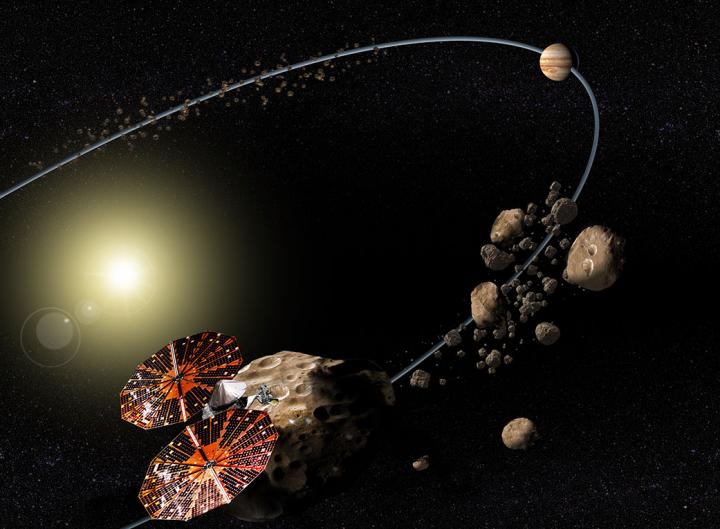NASA mission to the Trojan asteroids enters construction phase

Credit: NASA/Southwest Research Institute
SAN ANTONIO — Oct. 21, 2019 — The Lucy mission led by Southwest Research Institute is one step closer to its 2021 launch to explore the Trojan asteroids, a population of ancient small bodies that share an orbit with Jupiter. With the successful completion of its critical design review last week, the Lucy spacecraft is on track to begin a 12-year journey of almost 4 billion miles to visit a record-breaking seven asteroids — one main belt asteroid and six Trojans.
“The Trojan asteroids are leftovers from the early days of our solar system, effectively fossils of the planet formation process,” said SwRI’s Harold Levison, the principal investigator of the mission. “They hold vital clues to deciphering the history of our solar system. Lucy, like the human ancestor fossil for which it is named, will revolutionize the understanding of our origins.”
The design review was a major mission milestone. An independent board including members from NASA and several external organizations evaluated all aspects of the Lucy mission, from the spacecraft and instrument payload to flight hardware and software, systems engineering, mission assurance, ground systems and overall science mission. This marks the end of Lucy’s design phase and a shift to building the spacecraft and instruments that will explore the diverse Trojan asteroids.
“Lucy’s ability to fly by so many targets means that we will not only get the first up-close look at this unexplored population, but we will also be able to study why the asteroids appear so different,” said SwRI’s Cathy Olkin, deputy principal investigator of the mission. “The mission will provide an unparalleled glimpse into the formation of our solar system, helping us understand the source of volatiles and organics on the terrestrial planets and the evolution of the planetary system as a whole.”
Now that the Lucy mission has passed its critical design review, construction will begin in earnest. While Lockheed Martin is building the spacecraft, the Goddard Space Flight Center, the Johns Hopkins University Applied Physics Laboratory and Arizona State University will build a suite of complementary imaging and mapping instruments to remotely probe this enigmatic population of asteroids.
“The Lucy team has been working for over a year reviewing the designs of every system and subsystem,” said Goddard’s Donya Douglas-Bradshaw, Lucy’s project manager. “Through all this hard work, the team is doing everything possible to ensure a successful mission. The team is to be commended for their dedication.”
###
SwRI is the principal investigator institution and will lead the science investigation. Goddard will provide overall mission management, systems engineering, and safety and mission assurance.
To see a video about the Lucy mission, visit: https:/
For more information, visit lucy.swri.org or swri.org/planetary-science.
Media Contact
Deb Schmid
[email protected]
210-522-2254
Original Source
https:/




